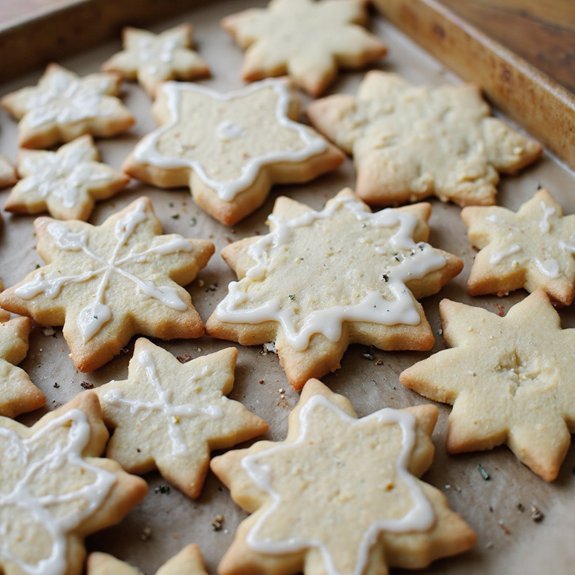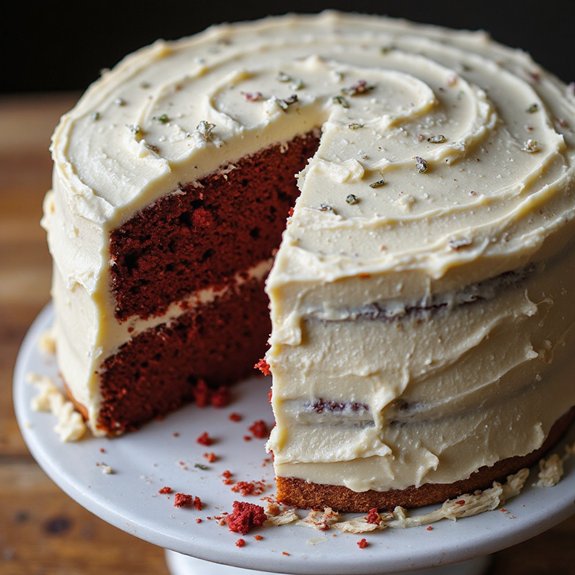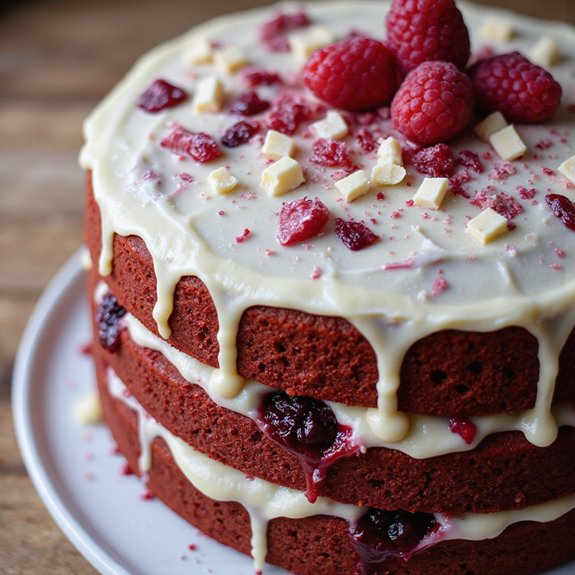Picture trays of buttery sugar cookies emerging golden at the edges, their soft centers perfumed with vanilla and a whisper of almond.
Imagine a snowfall of sprinkles catching the light as glossy icing sets, the kitchen warm and sweet with the aroma of holidays and home.
These are the cookies I return to when I want comfort you can hold—simple dough, tender bite, cheerful shapes that invite lingering around the counter.
One December, a last-minute school fundraiser collided with a chaotic workweek, and this reliable recipe saved the day—two chilled discs, quick bakes, and a decorating assembly line that turned stress into laughter.
They’re perfect for busy weeknights when you need a make-ahead treat, cozy Sunday suppers where dessert doubles as activity, or festive cookie swaps that call for something classic yet customizable.
I’ll walk you through every step so your batch bakes up beautifully the first time.
Ready? Let’s cook!
Why You’ll Love It
- Delivers classic buttery vanilla flavor with festive almond option
- Bakes into soft centers with lightly crisp, golden edges
- Holds sharp cookie-cutter shapes after easy chill time
- Uses simple pantry staples and basic kitchen equipment
- Decorates beautifully with quick, glossy vanilla icing
Ingredients
- 1 cup unsalted butter, softened — room-temp for easy creaming
- 1 cup granulated sugar — fine texture helps dissolve
- 1 large egg, room temperature — mixes more evenly
- 1 teaspoon vanilla extract — pure extract for best flavor
- 1/2 teaspoon almond extract, optional — adds classic bakery aroma
- 2 1/2 cups all-purpose flour, leveled — measure carefully to avoid dry dough
- 1/2 teaspoon baking powder — guarantees slight lift
- 1/2 teaspoon fine sea salt — balances sweetness
- Up to 2 tablespoons milk — add only if dough seems dry
- 1 cup powdered sugar — for smooth icing
- 2–3 tablespoons milk — thin icing to drizzleable consistency
- 1/2 teaspoon vanilla extract — flavors the icing
- Assorted sprinkles — add after icing for color and crunch
Step-by-Step Method
Cream Butter & Sugar
Beat softened butter and granulated sugar on medium speed until pale and fluffy, 2–3 minutes. Scrape the bowl.
Incorporate air for tender cookies. Avoid overbeating once fluffy. If using a stand mixer, use the paddle attachment. Proper creaming helps cookies hold sharp edges and bake evenly without excessive spread.
Add Egg & Extracts
Mix in the egg, vanilla, and almond extract until smooth and fully combined. Scrape the bowl to catch any streaks.
Keep speed on low–medium to prevent excess air. Make certain the egg is at room temperature for a uniform emulsion and a cohesive dough that rolls easily without cracking.
Combine Dry Ingredients
Whisk flour, baking powder, and salt in a separate bowl. Break up any lumps.
Make certain even distribution of leavening and salt for consistent rise and flavor. Keep the ratio precise by leveling flour. This dry mix prevents overmixing later and helps the dough come together quickly and tenderly.
Bring Dough Together
Add dry ingredients to the wet in two additions. Mix on low just until a soft dough forms.
Add up to 2 tablespoons milk only if the dough seems dry or crumbly. Stop mixing as soon as it clumps. Overmixing develops gluten and can toughen cookies. The dough should feel soft but not sticky.
Divide & Chill
Split dough into two equal portions. Flatten into discs about 1 inch thick. Wrap tightly in plastic.
Chill for 1 hour until firm. Cold dough rolls cleaner and keeps shapes sharp. Re-chill scraps between rerolls to prevent spread. Work with one disc at a time to keep temperatures low.
Preheat & Prep Pans
Heat the oven to 350°F (175°C). Line baking sheets with silicone mats or parchment paper. Clear space for cooling racks.
Prepare cookie cutters, extra flour for dusting, and a rolling pin. Organize tools now for faster shaping. Proper pan lining guarantees easy release and even browning.
Roll the Dough
Lightly flour the work surface and rolling pin. Roll one disc to 1/4 inch thickness.
Rotate the dough frequently and dust lightly as needed to prevent sticking. Keep the thickness even for uniform baking. If the kitchen is warm, roll between two sheets of parchment to avoid excess flour.
Cut Shapes Cleanly
Press cookie cutters straight down, then lift without twisting. Transfer shapes to prepared sheets, spacing about 2 inches apart.
Gather scraps, press together, and chill before rerolling. Work quickly to keep dough cool. Use an offset spatula for clean transfers and minimal distortion.
Bake to Just-Set
Bake each sheet for 8–10 minutes until edges are set and barely golden while centers remain pale. Rotate pans halfway if needed.
Pull earlier for softer cookies or leave 1–2 minutes longer for crisper ones. Avoid overbaking; carryover heat finishes the bake as cookies rest.
Cool Completely
Let cookies cool on the sheet for 5 minutes to firm up. Transfer carefully to a wire rack to cool completely before icing.
Cooling prevents melted icing and smudged decorations. Make certain cookies are fully cool to keep surfaces smooth and finishes glossy.
Mix Simple Icing
Whisk powdered sugar, milk, and vanilla until smooth and drizzleable. Aim for a ribbon that disappears in 10-12 seconds.
Add a few drops of milk to thin or a spoonful of powdered sugar to thicken. Make small batches in bowls if using multiple colors. Cover to prevent crusting.
Decorate & Set
Pipe or spoon icing over cooled cookies. Add sprinkles immediately so they adhere.
Let cookies sit undisturbed until icing firms. Speed setting by placing trays in a cool, dry spot. Store decorated cookies airtight up to 5 days, or freeze undecorated cookies and dough for future baking.
Ingredient Swaps
- Dairy-free: Use vegan butter 1:1; for icing, use plant milk.
- Egg-free: Replace 1 egg with 1 tbsp ground flax + 3 tbsp water (5 min gel) or 3 tbsp aquafaba.
- Gluten-free: Substitute a 1:1 gluten-free all-purpose blend (with xanthan gum). Chill well and roll slightly thicker.
- Nut-free: Omit almond extract; add 1/2 tsp extra vanilla or 1/4 tsp butter or lemon extract.
- Lower cost/availability: Use salted butter and reduce added salt to a pinch; skip almond extract; use water instead of milk in icing.
- Flavor swaps: Replace vanilla with peppermint, maple, or citrus zest; add 1/2 tsp cinnamon for a holiday twist.
You Must Know
- Doneness • If edges look matte but centers still glossy, pull the sheet promptly; carryover heat finishes them in 3–4 minutes on the pan. This keeps interiors tender and prevents browning past a light straw edge.
- Troubleshoot • When dough crumbles or cracks while rolling, knead in 1–2 teaspoons milk with fingertips until it feels like cool Play-Doh. Low hydration causes fissures; the dough should roll smoothly at 1/4 inch with no tearing.
- Avoid • Avoid warm, sticky dough that grabs the cutter; return it to the fridge 10–15 minutes until cool and slightly firm to the touch. Too-warm dough spreads and blurs shapes in the first 2–3 minutes of oven time.
- Scale • For double batches, weigh flour (300 g per 2 1/2 cups; total 600 g) to keep ratios precise. Volume scooping varies; a 10% excess flour makes cookies drier and reduces spread by about 1/8 inch.
- Flavor Boost • For a bakery-style finish, brush cooled cookies with a thin vanilla syrup (1 tablespoon sugar + 1 tablespoon water + 1/4 teaspoon vanilla) and let dry 10 minutes before icing. It adds moisture and a pronounced aroma without changing texture.
Serving Tips
- Arrange on a tiered platter with rosemary sprigs and cranberries for festivity.
- Pair with hot cocoa, mulled cider, or peppermint lattes for a cozy treat.
- Offer an icing-and-sprinkles decorating station for guests to personalize cookies.
- Gift in clear bags with ribbon and a handwritten holiday tag.
- Serve alongside vanilla ice cream for a simple, crowd-pleasing dessert.
Storage & Make-Ahead
Store decorated cookies airtight at room temperature up to 5 days.
In the fridge, they keep 7–10 days.
Make dough ahead: wrap discs tightly and chill up to 3 days.
Baked, undecorated cookies and dough freeze well for up to 2 months.
Thaw overnight in the fridge before rolling, baking, or decorating.
Reheating
Reheat gently.
Microwave 1–2 cookies 8–12 seconds wrapped in a slightly damp towel.
Oven at 300°F for 4–6 minutes on a sheet.
Stovetop: covered skillet low heat 2–3 minutes.
Grandma’s Tin Tradition
Once those cookies are warm again and smelling like butter and vanilla, I tuck them into Grandma’s old tin—the red one with the dented lid and snowflake rim.
The metal clicks shut like a promise.
You don’t need a perfect heirloom; any clean, dry tin with a snug lid carries the magic.
Line it with parchment, not plastic, so the cookies keep their delicate snap and tender centers.
I stack by size, separating layers with parchment squares to protect icing and sprinkles.
Slip a single sugar cube or a dry paper towel inside to gently balance moisture—no sogginess, no staleness.
Then I set the tin on the table where hands can find it.
Open, share, close.
The ritual keeps the cookies—and the stories—fresh.
Final Thoughts
Ready to bake some holiday magic? Give these Christmas Sugar Cookies a try as written, or tweak the flavors with citrus zest, peppermint, or your favorite sprinkles to make them your own!
Frequently Asked Questions
How Do I Troubleshoot Dough That Cracks When Rolling?
Warm it slightly and add a teaspoon of milk, then knead gently until supple. I dust lightly, roll between parchment, and re-chill scraps. If edges still crack, let it rest—dough relaxes like winter snow settling.
Can I Make These Cookies Gluten-Free Successfully?
Yes—you can. I swap in a 1:1 gluten-free baking blend with xanthan gum, add 1–2 tablespoons milk, and chill longer. I roll between parchment, reroll scraps cold, and bake just until edges whisper gold.
What Altitude Adjustments Are Needed for Baking Times?
Increase bake time slightly at higher altitudes: I add 1–2 minutes at 3,000–5,000 feet, 2–3 minutes above. I’ll also reduce sugar a tablespoon, add a splash of milk, and watch lightly golden edges.
How Do I Prevent Icing Colors From Bleeding?
Let colors set fully between layers, I whisper. I dry cookies overnight, use thicker icing, minimal water-based dyes, and light pressure. I pipe outlines first, avoid humid rooms, and store decorated cookies loosely, not stacked.
Which Natural Food Dyes Work Best for Holiday Colors?
Use beet or hibiscus for red, matcha or spinach for green, turmeric for gold, and butterfly pea for blue. I whisk them into icing, start pale, deepen slowly, and add lemon to brighten hues. Test tiny batches.

Homemade Christmas Sugar Cookies
Equipment
- 2 Mixing bowl
- 1 electric hand mixer or stand mixer
- 1 Measuring cups set
- 1 Measuring spoons set
- 1 Rubber spatula
- 1 Whisk
- 2 Baking sheet
- 2 silicone baking mat or sheet of parchment paper
- 1 Rolling Pin
- 3–4 Cookie cutter
- 1 wire cooling rack
Ingredients
- 1 cup unsalted butter softened
- 1 cup granulated sugar
- 1 large egg room temperature
- 1 teaspoon vanilla extract
- 1/2 teaspoon almond extract optional
- 2 1/2 cup all-purpose flour leveled
- 1/2 teaspoon baking powder
- 1/2 teaspoon fine sea salt
- 2 tablespoon milk as needed
- 1 cup powdered sugar for icing
- 2–3 tablespoon milk for icing
- 1/2 teaspoon vanilla extract for icing
- assorted sprinkles for decorating
Instructions
- Cream the softened butter and granulated sugar together in a mixing bowl with an electric mixer on medium speed until light and fluffy, about 2–3 minutes.
- Beat in the egg, vanilla extract, and almond extract until fully combined.
- In a separate bowl whisk together the all-purpose flour, baking powder, and salt.
- Add the dry ingredients to the wet ingredients in two additions, mixing on low just until a soft dough forms, adding up to 2 tablespoons milk if dough seems dry.
- Divide the dough in half, flatten into discs, wrap tightly, and chill for 1 hour until firm.
- Preheat the oven to 350°F (175°C) and line baking sheets with silicone mats or parchment.
- On a lightly floured surface roll one dough disc to 1/4 inch thickness, rotating and lightly flouring as needed to prevent sticking.
- Cut shapes with cookie cutters and transfer to prepared baking sheets spacing about 2 inches apart.
- Bake each sheet for 8–10 minutes until edges are set and just barely golden.
- Cool cookies on the sheet for 5 minutes, then transfer to a wire rack to cool completely.
- Whisk powdered sugar, milk, and vanilla for icing to a smooth drizzleable consistency.
- Decorate cooled cookies with icing and sprinkles, then let set until icing is firm.





